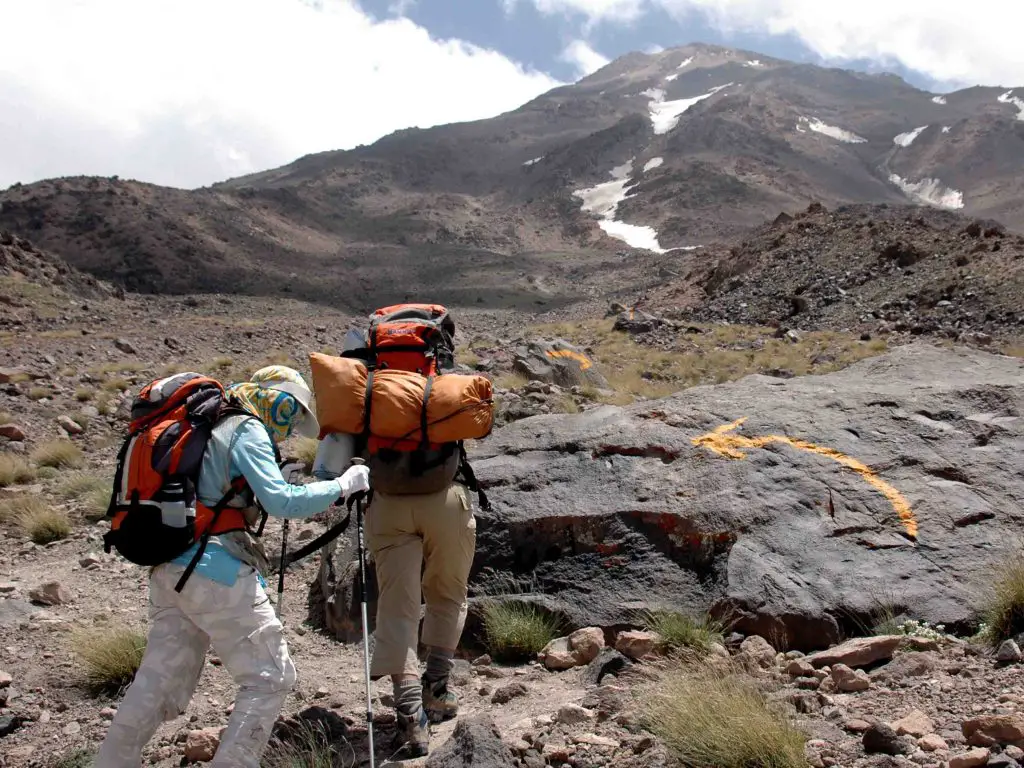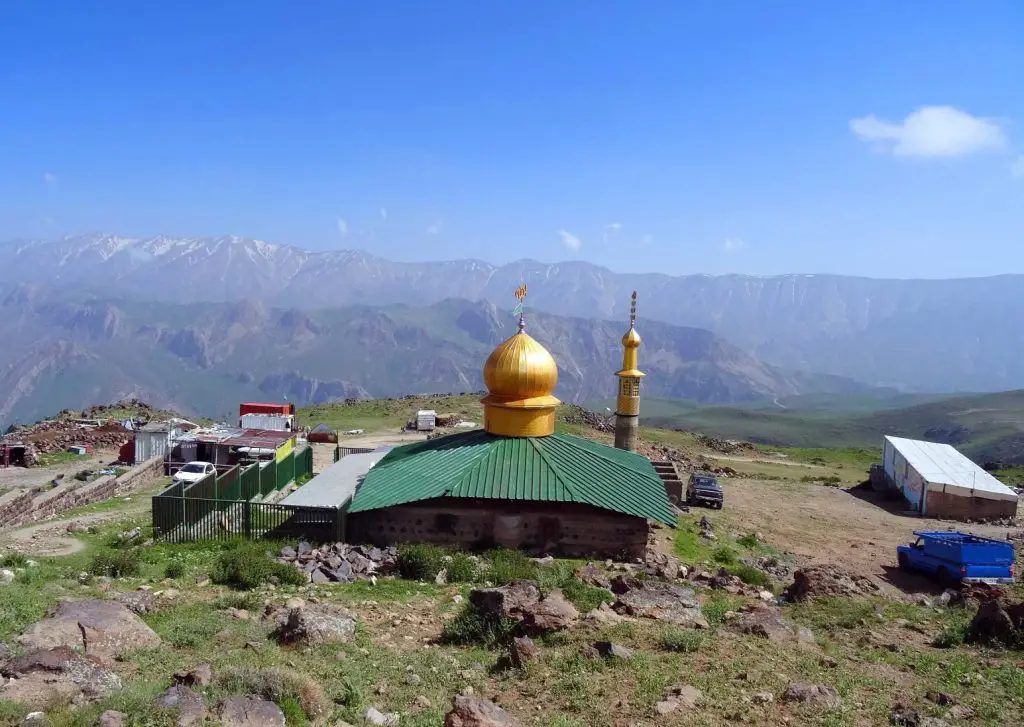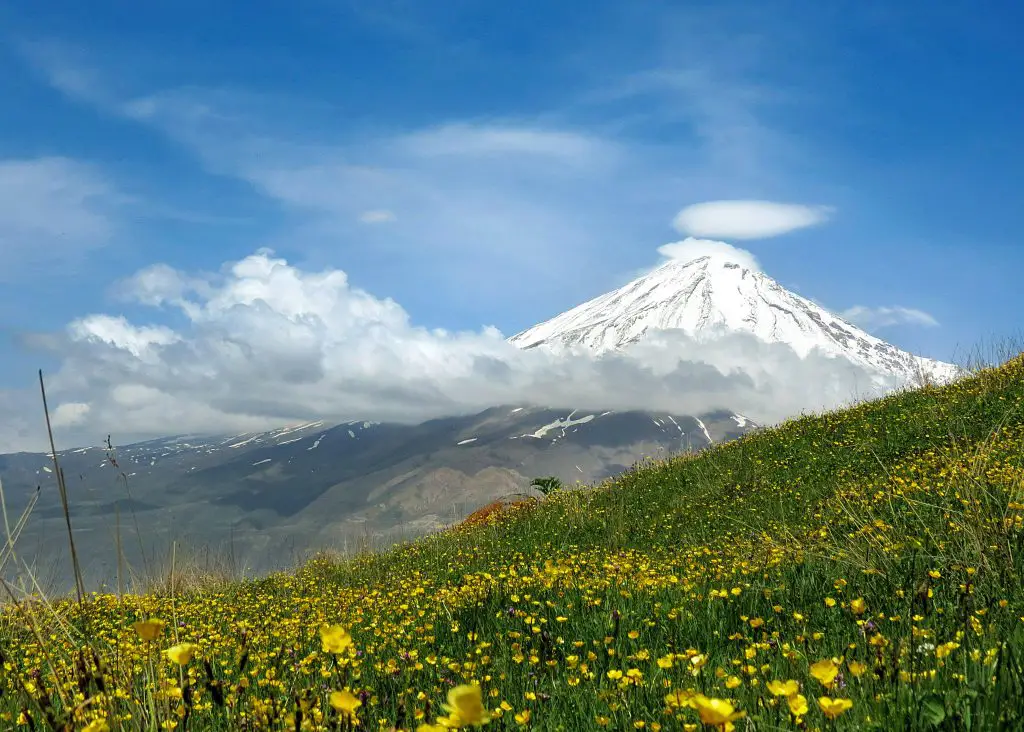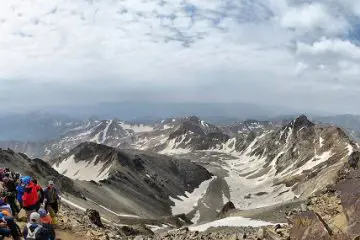Dream of summiting Asia’s highest volcano, Mount Damavand? Reading this summit guide for Mount Damavand’s South Face Route, will be your first step at realizing this dream. The southern face route is the least challenging route for summitting Damavand mountain and one of the most popular. Interested? Then here’s all you need to know for a nice ascent of Iran’s highest mountain through this route.
Contents
- 1 The Camps on Mount Damavand’s South Face
- 2 Mount Damavand’s Southern Face Ascending Guidelines
- 3 The Best Time to Summit Mount Damavand Through the South Face
- 4 Cell-Phone Signal Reception on Mount Damavand’s South Face
- 5 Where You Can Get Water on Mount Damavand’s Southern Face
- 6 Certificate of Successful Ascent
- 7 What to Pack for Mount Damavand
- 8 Like to Go on an Adventure on Mount Damavand’s South Face?

The Camps on Mount Damavand’s South Face
- Mountain Shelters in the Nearby Villages: At the shelters at Polour (southern face) and Rineh (southern face), you can spend the night, get yourself a mountain guide and find off-road cars that can take you to the starting point of the ascent. The facilities at Polour camp are a dorm, WC and parking.
- Sahebazzaman Mosque: It is a mountain hut built in 1992. It is at a 3000-meter altitude on the Southern face.

- Bargah-e Sevvom Hut (the old): Built in 1967 at a 4200-meter altitude. An avalanche in 1973 destroyed this hut. So, it was replaced with a stone structure a year later. There is also a camping area around it.
- Bargah-e Sevvom Shelter (the new): Built in 2009, 50 meters higher than the old Bargh-e Sevvom Hut (on the southern face). This shelter includes first aid room, backpack storage, public storage, dining room, kitchen, public bedroom, private bedroom, and public restrooms.

Mount Damavand’s Southern Face Ascending Guidelines

1- Off to Polour (Day 1)
The southern face route is the easiest route for summitting Mount Damavand. To access this route, you have to go to Polour Village first. It is a village on the foot of Damavand and a camp for mountaineers who want to conquer Iran’s highest mountain. Polour Mountaineering Camp (2200m) is outside the village. You can find it in the beginning of the road that leads to Lar Dam. Shop for food before reaching Gusfandsara, because there, you’ll only find a small shop that sells overpriced tea, water and snacks. There is no spring up to Bargah-e Sevvom. So, carry enough water with you.

2- Polour to Gusfandsara (Day 1)
Take the Lar road and make your way toward Rineh. A little after Polour Shelter, the asphalted road divides in two. The straight road leads to the lake of Lar Dam and the western parking. And the road on the right leads you to Rineh. Pick the one toward Rineh. After about 5 km, you’ll reach a dirt road marked with a sign of Damavand Natural Resources. This place is known as the southern Parking and is the starting point for summitting Mount Damavand’s South Face. There, you can find land rovers that take mountaineers to Gusfandsara (2950m). The road trip takes about one hour.
Though the road trip sounds easier and time-saving, hiking this part of the road is more rewarding. The route is not only eye-catching, but you can also enjoy smelling wild mountain plants (specially oregano) throughout your hike (3 hours). Plus, choosing to hike up this road reduces the damages the tires of off-road cars cause in nature.

3-Gusfandsara to Bargah-e Sevvom (Day 1)
There are donkeys that will carry your backpacks from the beginning of Gusfandsara route to Bargah-e Sevvom (the price was 1’000’000 Rials in 2019). When you start the ascent, it might be sunny and mild, but don’t let this pleasant weather trick you. Don’t put all of your food and clothing in the backpack that the donkeys carry to Bargah-e Sevvom. Because it takes about 5 hours to reach Bargah-e Sevvom and it is probable that the weather will change. So, take your raincoat, rain cover and warm clothing.

4-Bargah-e Sevvom (Day 1)
On your way to summit Mount Damavand through the south face, you’ll find a shelter known as Bargah-e Sevvom. The shelter can shelter up to 50 persons and there is a camping area around it. To stay in the shelter, you’ll have to reserve a place in advance. There is a WC near the shelter and you can get fresh water from the spring behind the shelter. Bargah-e Sevvom is 4200 meters above sea level. At this altitude, you’ll have the symptoms of mountain sickness. If you are not familiar with this vital concept, check out our blog on the symptoms of mountain sickness.
Note: Bargah-e Sevvom isn’t in a good condition and Damavand needs your friendship. So, carry large garbage bags with yourself to carry all of your garbage with yourself down the mountain.
Note: Please don’t camp at the helideck beside Bargah-e Sevvom. Because if a rescue helicopter intends to land on it, you might slow the rescue process. Also, the wind that the helicopter creates can throw all of your stuff around and cause damages to them.

5-Acclimatization (Day 2)
To adapt yourself to the height, dedicate the second day to acclimatization. So, have an ascent to the altitude of almost 4600m. Having had an optimal acclimatization, climb down to spend the night in the shelter.
6-Bargah-e Sevvom to the Summit and Back (Day 3)
The best time to start the ascent from Bargah-e Sevvom is about 3 to 4 am. Because it takes about 6 hours to reach the summit and 3 hours to get back down to the shelter (9 hours totally). This way, you’ll be on the summit at around 10 am.
On the route, you can enjoy natural attractions like Damavand’s frozen waterfall (5000m) and the sulfur hill near the summit. At the sulfur hill area, you’ll have to tolerate a very strong and bad smell. The soil on this hill is sulfur and it will create severe irritation if it touches your eyes. The sulfur hill that still emits sulfur gasses makes the mountaineers last steps more difficult. The frozen bodies of a flock of sheep and mountain goats is the known symbol of Damavand’s summit. How and why the flock got to the summit and why they died is unclear. After joining the summiteers of Damavand Mountain, trek back down to the shelter.
Note 1: Strong sunshine starts at 7 am and reaches its peak at 12 pm. So, take your mountaineering sunglasses.
Note 2: Take a flask of boiling water with you so that if it gets very cold, you can warm yourself with a cup of hot tea or coffee.
Note 3: Having an oxygen spray with you is highly recommended. You can get these sprays from drug stores.
Note 4: To supply your body with sugar and carbohydrates, bring dates, biscuits or boiled potatoes with you.

7. The Way Down from Bargah-e Sevvom (Day 4)
The return route on Mount Damavand’s Southern Face is long. So, take enough water and dates and slow it down to avoid hurting your knees. Take a trek (about 2 hours) down to Gusfandsara (3200m). From there, get a ride (about 1 hour) to Polour (2300m).
The Best Time to Summit Mount Damavand Through the South Face
The southern face is one of the ways to reach the summit. The best time to do it is usually mid-July to late August. Early in August is the South Face’s most populated time. Because the cold and the winds on the summit reduce in mid-summer, it’s the time when Mount Damavand becomes a host to a larger number of mountaineers. On the other hand, there still is a high chance of heavy snowfall and blizzard around Bargah-e Sevvom Shelter even in Mid-summer.

Cell-Phone Signal Reception on Mount Damavand’s South Face
IranCell and Hamrah Avval SIM cards have a high reception up to Bargah-e Sevvom. Hamrahe Avval SIM cards have reception and internet coverage even on the summit. So, don’t worry about starting a live video on the summit.
Where You Can Get Water on Mount Damavand’s Southern Face
There is no spring on the route and potable water is only available at Bargah-e Sevvom Shelter.
Certificate of Successful Ascent
To get a certificate of your successful ascent of Mount Damavand through the southern route, take a solo photo of yourself on the summit. Take the photo to Polour Mountaineering Federation. The cost of this certificate is 50 € in 2022.
What to Pack for Mount Damavand
- Summer mountaineering shoes
- Suitable mountaineering pants and a pair of warm base-layer pants
- Suitable mountaineering clothing
- Mountaineering gloves (preferably feather gloves)
- Rain jacket suitable for summitting
- Mountaineering backpack (35 liters)
- Mountaineering tent (if it’s heavy, a donkey can carry it for you)
- Tent wind ropes (for the strong winds at Bargah-e Sevvom)
- Mountaineering sunglasses
- Small flask to carry boiling water
- Suitable sleeping bag
- Sleeping bag mats (to avoid becoming frostbitten)
- Wool hat
- Sunscreen
- Food for 4 meals
- Mountaineering cooking equipment
- Gelofen pills
- Oxygen spray
- Camera

Like to Go on an Adventure on Mount Damavand’s South Face?
All of our Damavand trekking adventures are through this face. So pick our 4-day Mount Damavand-South Face tour, our 9-day Alam and Damavand tour, our 8-day Sabalan and Damavand tour, our 7-day Sialan and Damavand tour, our 12-day Zard Kuh and Damavand tour, or our Mount Damavand and Raghez Canyon tour.


















Comments